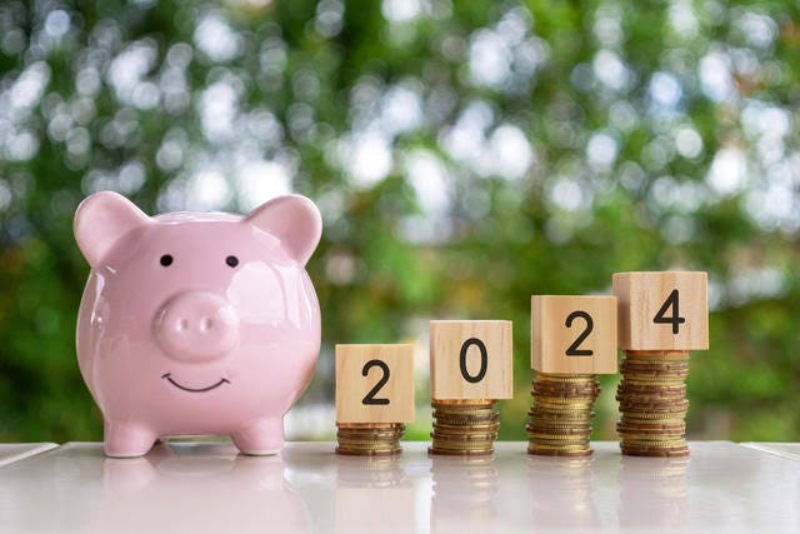Business
Top 15 Ways To Increase Your Savings in 2024

Everyone knows they should save money, but it can be difficult to start, so it never hurts to utilize some money-saving advice. You might believe that if you don’t feel like you have any spare money to save, you should reevaluate your long-term financial objectives. Changing a few spending habits could be all it takes to see your bank account balance increase, rather than taking on eight more side projects to save a significant amount of money.
How To Save Cash: 15 Simple Steps
Rethink your beliefs if you believe you have no money to save, are unsure of where to begin, or have come to believe you aren’t a saver at all. Transferring funds from your checking account to your high-yield savings account is something you can do at any time. Here are fifteen things to think about:
- Create a grocery list and follow it.
- Eat at home to save money on eating out.
- Purchase store brands.
- Look for methods to reduce wasteful spending.
- Move credit card amounts.
- Look around the supermarket store’s perimeter.
- Observe the 30-day guideline.
- Refinance your mortgage.
- Utilize a budgeting software.
- Reduce energy use and electricity costs.
- Set up an automated savings account.
- Create a budget and divide it by the percentages.
- Examine your spending
- Reduce your debt.
- Establish savings objectives.
1. Create A Grocery List and Follow It
An astounding $444 billion worth of food is wasted annually by Americans—about 80 million tons of food. You’re tossing money down the garbage if you throw food out all the time. Making a grocery list, meal plan, and shopping list and following it can help reduce waste by preventing food and money waste.
Make sure to prepare your lunch for work and start by organizing your meals for the next week or the duration of your pay period. After you’ve scheduled your meals, compile a shopping list with every item you need. By doing this, you can ensure that you have what you need for the meals you want to prepare and avoid buying too much.
2. Eat at Home Instead of Paying at Restaurants
It’s no secret that eating out can be more costly than preparing meals at home. One simple approach to add some funds to your bank account is to make a greater effort to dine at home. Reducing your dining out expenses might significantly increase your monthly budget and provide you with more cash to save for a rainy day.
3. Purchase Store-Name Items
Store brands may not have the prettiest labels, but the items are just as good as, if not better than, well-known brands. For instance, you’ll discover that drugs sold under different brands contain the same active components. You can increase the amount of change in your piggy bank by switching to the store brand for additional things, such prescriptions.
4. Look for Methods To Reduce Wasteful Spending
An average person’s monthly cost for cable services is approximately $74. The monthly cost of the base subscriptions at Hulu, Netflix, Disney Plus, and HBO Max would be $33. Making the switch to those streaming services will save you $41 a month. What other wasteful expenses could you eliminate from your spending plan to create savings?
5. Credit Card Balance Transfers
Credit card debt with high interest rates can add up rapidly, but if your credit is strong, you won’t be charged interest at those exorbitant rates. Take into account applying for a credit card with a zero-interest balance transfer. You could be able to save hundreds or even thousands of dollars by doing this, as interest costs can be avoided for up to 21 months.
You can concentrate on making better choices for your charge habits after you have greater control over your credit card debt. To save money, consider incentives or cash-back credit cards.
6. Look Around The Supermarket Store’s Perimeter
Ever notice how fresh the goods are that are located on the outside of the grocery store? These are all the fresh items you need to prepare delicious meals at home, including meats and vegetables. This is the proper store to shop at. Staying away from pre-packaged meals can benefit your health in addition to helping you on your quest to learn how to save money.
7. Observe The 30-day Guideline
Ever ask yourself, “What is the 30-day rule?” This guideline was made to prevent expensive impulsive purchases for both you and other people.
The simple rule is to wait 30 days before buying something new that catches your eye. Take it if, after 30 days, you still desire it. If you give yourself 30 days to consider the products, you’ll probably be surprised at how many you decide not to buy.
8. Get a Mortgage Refinance
Is your mortgage payment excessive? It’s possible that you bought your house while interest rates were high. Your starting balance determines how much your mortgage payment will be even if you didn’t. If you refinance, your interest rate might go down, and if you’ve paid off a large amount of your house, your payments might go down even if your interest rate stays the same.
9. Use an App for Budgeting
It’s a fact that not everyone has mastered the art of budgeting, and that’s acceptable. It is not taught in elementary school how to create a budget. Take charge of your finances by utilizing a budgeting program like EveryDollar or Goodbudget if you struggle to find money for saves.
10. Lower Your Utility Bills
Over the course of a year, the simple act of turning off your lights when you’re not using them will significantly increase your savings. You might increase these savings by entirely shutting off your thermostat while at work or adjusting it by one degree based on the outside temperature. These are but a few strategies for cost-cutting. When you go outside the box, there are a ton of other ways you may reduce your utility costs.
11. Set Up an Automated Savings Account
It’s simpler to resist spending when money is automatically deducted from your paycheck. To establish your foundation or assist you in meeting your savings objectives, you can select a portion of your income to go straight into savings accounts. Here are some pointers:
- Create a different savings account and set up an automated transfer from your paycheck into it so that money stays out of sight and out of mind.
- To obtain a greater interest rate, look for a high-interest savings account, certificate of deposit, or money market account. Where you keep your money matters.
- Payroll direct deposit is easy, but you have the option to divide up the deposits. For instance, allocate a portion of your funds to a designated account for essential expenses such as rent, utility or power bills, auto insurance, or phone bills.
- It’s possible to automate bill payment, which will assist you in accounting for your essential expenses and controlling your discretionary spending.
12. Follow the 50/30/20 Rule
Are you curious about the 50/30/20 rule and whether it applies to you? The idea is straightforward. You should set aside 50% of your income for savings, 30% for wants, and 50% for requirements. To maintain this, you might need to adjust your way of living, but the long term benefits make the effort worthwhile.
13. Examine Your Outlays
Making a thorough assessment of your monthly spending is one approach to reduce costs and improve your spending habits. This makes it easier to see where you can make edits. Unused subscriptions that you automatically pay for each month are a wonderful place to start. Unused gym memberships and phone apps that you pay for covertly are two more areas where you can make savings.
14. Reduce Your Debt
Paying off debt—student loans or credit card debt—may seem apparent, but it’s one of the finest strategies to get your finances moving in the right direction once more. Paying your bills on time and in full will help you get better credit as well as reduce the interest rates you pay. Better rates and cost reductions on subsequent loans may result from this.
15. Make Savings Objectives
The responsibility of setting and achieving objectives can be the key to maintaining motivation to save more and spend less. Creating a budget and setting savings goals are similar in that you simply identify your financial goals and the activities you need to take to achieve them. Here are a few examples of objectives you could strive for:
- Establish an emergency fund with three to six months’ worth of spending covered in case something unforeseen occurs.
- setting aside sufficient cash for a down payment on major purchases like homes or autos.
- boosting retirement account balances and savings to assist you and your family create a more secure future.
-

 Sports4 weeks ago
Sports4 weeks agoFIFA Club World Cup 2025: Complete List of Qualified Teams and Groups
-

 Sports3 weeks ago
Sports3 weeks agoAl Ahly vs Inter Miami, 2025 FIFA Club World Cup – Preview, Prediction, Predicted Lineups and How to Watch
-
Health2 weeks ago
Back to Roots: Ayurveda Offers Natural Cure for Common Hair Woes
-

 Tech2 weeks ago
Tech2 weeks agoFrom Soil to Silicon: The Rise of Agriculture AI and Drone Innovations in 2025
-

 Sports4 weeks ago
Sports4 weeks agoFIVB Men’s Volleyball Nations League 2025: Full Schedule, Fixtures, Format, Teams, Pools and How to Watch
-

 Startup3 weeks ago
Startup3 weeks agoHow Instagram Is Driving Global Social Media Marketing Trends
-

 Sports3 weeks ago
Sports3 weeks agoWorld Judo Championships 2025: Full Schedule, Date, Time, Key Athletes and How to Watch
-

 Sports2 weeks ago
Sports2 weeks agoFIBA 3×3 World Cup 2025: Full Schedule, Preview, and How to Watch

























